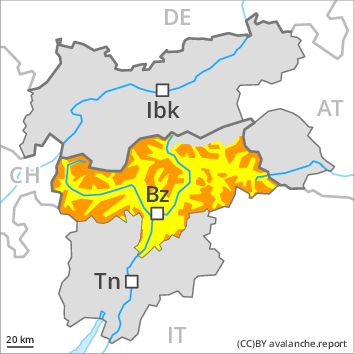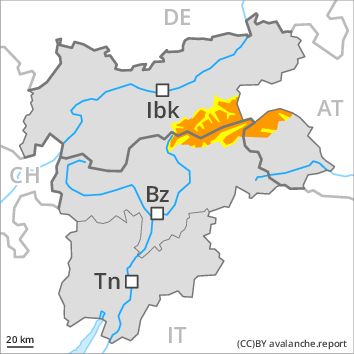Regions
Sexten Dolomites, Eastern Pfunderer Mountains, Western Rieserferner Mountains, Val Müstair Alps, Western Deferegger Alps, Langtaufers, Ortler Range, Schnals Ridge, Southern Stubai Alps, Ulten Valley, Eastern Nonsberger Alps, Northern Dolomites of Fiemme, Saldurn-Mastaun Ridge, Gröden Dolomites, Texel Mountains, Prags Dolomites, Sarntal Alps, Western Pfunderer Mountains

Danger level
Danger Level 3 - Considerable above the treeline
Danger Level 2 - Moderate above the treeline
Avalanche Problem
Wind-drifted snow above the treeline, N-NE-E-SE-S-SW-W-NW
Gliding snow above 2400m, N-NE-E-SE-S-SW-W-NW

The fresh wind slabs represent the main danger.
Even single winter sport participants can release avalanches easily, including dangerously large ones. The wind slabs are to be found in particular adjacent to ridgelines and in gullies and bowls in all aspects as well as at high altitudes and in the high Alpine regions. The current avalanche situation calls for experience in the assessment of avalanche danger. Caution and restraint are advisable.
Especially below approximately 2400 m small and medium-sized gliding avalanches and moist snow slides are possible.
Snowpack
dp 6: cold, loose snow and wind
dp 2: gliding snow
Some snow will fall in particular in the north. Up to 10 cm of snow. will fall. The wind will be moderate to strong adjacent to ridgelines. The wind slabs have bonded poorly with the old snowpack. Faceted weak layers exist in the old snowpack in particular adjacent to ridgelines. The old snowpack will be moist below approximately 2200 m.
Tendency
Wind slabs represent the main danger. A latent danger of gliding avalanches exists.
Regions
Durreck Range, Northern Zillertal Alps, Venediger Range, Southern Zillertal Alps and High Tauern

Danger level
Danger Level 3 - Considerable above the treeline
Danger Level 2 - Moderate above the treeline
Avalanche Problem
Wind-drifted snow above the treeline, N-NE-E-SE-S-SW-W-NW
Gliding snow above the treeline, N-NE-E-SE-S-SW-W-NW

Fresh wind slabs above approximately 2000 m.
Hardly any increase in avalanche danger as a consequence of the fresh snow. Fresh and somewhat older wind slabs are in isolated cases quite large and prone to triggering. Caution is to be exercised in particular adjacent to ridgelines, and elsewhere on steep slopes especially at high altitudes and in high Alpine regions. Dry avalanches can additionally be released in near-surface layers, even by a single winter sport participant.
As the penetration by moisture increases small to medium-sized gliding avalanches and moist snow slides are possible. This applies in particular on steep grassy slopes at low and intermediate altitudes.
The current avalanche situation calls for experience in the assessment of avalanche danger. Caution and restraint are advisable.
Snowpack
dp 6: cold, loose snow and wind
dp 2: gliding snow
Over a wide area 10 to 20 cm of snow, but less in some localities, will fall above approximately 600 m. The fresh and older wind slabs are poorly bonded with the old snowpack in all aspects above approximately 2000 m. The snowpack will be subject to considerable local variations at high altitudes and in high Alpine regions.
At low and intermediate altitudes the snow is moist.
Tendency
Slight decrease in avalanche danger as a consequence of the ceasing of precipitation.


